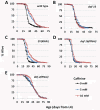Caffeine extends life span, improves healthspan, and delays age-associated pathology in Caenorhabditis elegans
- PMID: 24764514
- PMCID: PMC3922918
- DOI: 10.1186/2046-2395-1-9
Caffeine extends life span, improves healthspan, and delays age-associated pathology in Caenorhabditis elegans
Abstract
Background: The longevity of an organism is influenced by both genetic and environmental factors. With respect to genetic factors, a significant effort is being made to identify pharmacological agents that extend life span by targeting pathways with a defined role in the aging process. On the environmental side, the molecular mechanisms responsible for the positive influence of interventions such as dietary restriction are being explored. The environment experienced by humans in modern societies already contains countless compounds that may influence longevity. Understanding the role played by common compounds that substantially affect the aging process will be critical for predicting and interpreting the outcome of introducing new interventions. Caffeine is the most widely used psychoactive drug worldwide. Prior studies in flies, worms, and mice indicate that caffeine may positively impact age-associated neurodegenerative pathology, such as that observed in Alzheimer's disease.
Results: Here we report that caffeine is capable of extending life span and improving healthspan in Caenorhabditis elegans, a finding that is in agreement with a recently published screen looking for FDA-approved compounds capable of extending worm life span. Life span extension using caffeine displays epistatic interaction with two known longevity interventions: dietary restriction and reduced insulin signaling. Caffeine treatment also delays pathology in a nematode model of polyglutamine disease.
Conclusions: The identification of caffeine as a relevant factor in aging and healthspan in worms, combined with prior work in both humans and rodents linking caffeine consumption to reduced risk of age-associated disease, suggests that caffeine may target conserved longevity pathways. Further, it may be important to consider caffeine consumption when developing clinical interventions, particularly those designed to mimic dietary restriction or modulate insulin/IGF-1-like signaling. The positive impact of caffeine on a worm model of polyglutamine disease suggests that chronic caffeine consumption may generally enhance resistance to proteotoxic stress and may be relevant to assessing risk and developing treatments for human diseases like Alzheimer's and Huntington's disease. Future work addressing the relevant targets of caffeine in models of aging and healthspan will help to clarify the underlying mechanisms and potentially identify new molecular targets for disease intervention.
Keywords: Aging; Caffeine; Healthspan; Life span; Longevity; Neurodegeneration; Proteotoxicity; Worms.
Figures









References
Grants and funding
LinkOut - more resources
Full Text Sources
Other Literature Sources

